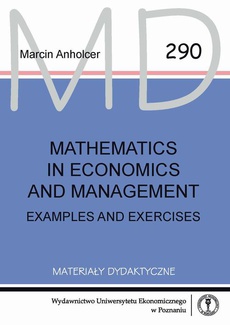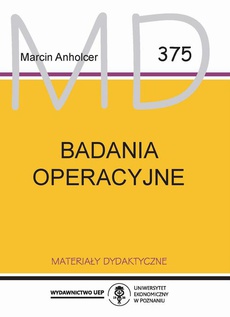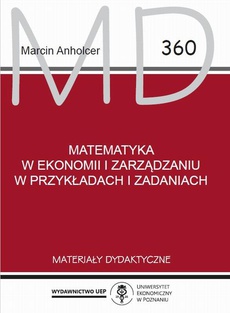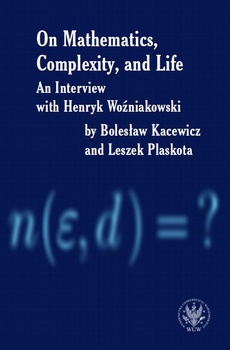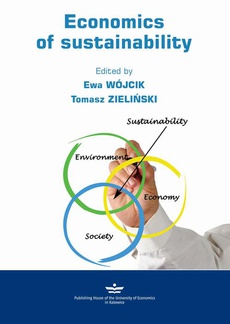INNE EBOOKI AUTORA
Mathematics in economics and management. Examples and exercises
Autor:
Wydawca:
Format:
pdf, ibuk
The book has been developed for students of first year courses in International Relations, Finance and Management. It is prepared in a way that allows you to learn by yourself. Hence, great emphasis was placed on the examples. They are resolved “step by step” to make it easy to understand them. Author also briefly discussed some of the issues that should be discussed in high school, but often cause some trouble: solving polynomial and rational equations and inequalities, basic properties of exponential and logarithmic functions. Chapters 1, 2 and 3 introduces you to the basic issues related to logic and set theory. It has been discussed, inter alia, issues such as the sentence algebra, quantifiers, set theory, and relations. Chapters 4 and 5 presents the basics of linear algebra. You will learn from it how to apply arrays, vectors, determinants and linear systems in economics. Chapters 6–13 contains the basic concepts of calculus and their economic applications. So here you will find the methods of determining the limits and derivatives, finding the extrema, and solving the differential and difference equations. In chapters 12 and 13 you will find, among others, the information about marginal analysis and foundations of financial mathematics. The last chapter (14) presents the foundations of probability theory, including most important from the point of view of your future work, random variables. Each chapter consists of at least two sections, almost each section consists of four parts. First of them is a short theoretical introduction (it is enough for understanding the examples and solving the exercises, but it is not exhausting the topic). Almost each theoretical part ends with a short description of how to use WolframAlpha® to solve the examples of respective kind. WolframAlpha® is a free web application derived by Wolfram. The book is a extended version of the Polish book “Matematyka w ekonomii i zarządzaniu w przykładach i zadaniach” by Marcin Anholcer (MD 360, Poznań University of Economics, 2020). Author hopes that it will expand your mathematical knowledge and help you in passing the math exam.
| Rok wydania | 2020 |
|---|---|
| Liczba stron | 282 |
| Kategoria | Zarządzanie, organizacja, strategie |
| Wydawca | Uniwersytet Ekonomiczny w Poznaniu |
| ISBN-13 | 978-83-8211-030-2 |
| Numer wydania | 1 |
| Język publikacji | angielski |
| Informacja o sprzedawcy | ePWN sp. z o.o. |
POLECAMY
Ciekawe propozycje
Spis treści
| Introduction | |
| Chapter 1. Logic | |
| 1.1. Sentences | |
| 1.2. Quantifiers | |
| Chapter 2. Sets | |
| 2.1. Basic Concepts | |
| 2.2. Cartesian Product | |
| 2.3. The Inclusion–Exclusion Principle | |
| Chapter 3. Relations | |
| 3.1. Describing the Relations | |
| 3.2. Properties of the Relations | |
| 3.3. Orders and Preferences | |
| 3.4. Pareto Efficiency | |
| Chapter 4. Matrices and Vectors | |
| 4.1. Basic Concepts. Matrix Algebra | |
| 4.2. Elementary Operations | |
| 4.3. Linear Independence of Vectors and Matrix Rank | |
| 4.4. Determinants | |
| 4.5. Matrix Inverse | |
| Chapter 5. Linear Systems | |
| 5.1. Systems of Linear Equations | |
| 5.2. Systems of Linear Inequalities | |
| 5.3. Foundations of Linear Programming | |
| Chapter 6. Basic Functions and Their Properties | |
| 6.1. Basic Concepts | |
| 6.2. Polynomials and Rational Functions | |
| 6.3. Exponential Function | |
| 6.4. Logarithmic Function | |
| Chapter 7. Sequences and Series | |
| 7.1. Sequences and Their Limits | |
| 7.2. Arithmetic and Geometric Progressions | |
| 7.3. Sums and Series | |
| Chapter 8. Functions of One Variable | |
| 8.1. Limits | |
| 8.2. Derivatives | |
| Chapter 9. Functions of Many Variables | |
| 9.1. Functions of Many Variables and Their Derivatives | |
| 9.2. Local Extrema | |
| 9.3. Conditional Extrema | |
| Chapter 10. Integral Calculus | |
| 10.1. Indefinite Integrals | |
| 10.2. Definite and Improper Integrals | |
| Chapter 11. Differential and Difference Equations | |
| 11.1. Differential Equations | |
| 11.2. Difference Equations | |
| Chapter 12. Applications of Calculus in Economics | |
| 12.1. Differential Calculus | |
| 12.2. Important Functions | |
| Chapter 13. Financial Mathematics | |
| 13.1. Compound Interest, Streams of Money and IRR | |
| 13.2. Loan Repayment Schedule | |
| Chapter 14. Probability | |
| 14.1. Basic Concepts | |
| 14.2. Random Variable | |
| 14.3. Appendix: Cumulative Distribution of N(0, 1) | |

